New research warns that an amount of plastic equivalent to less than three sugar cubes could be fatal to seabirds, including the Atlantic puffin.
Plastics in the ocean pose an “existential threat” to marine biodiversity, with even small doses being potentially lethal.
New alarming research conducted by experts from Ocean Conservancy warns that thousands of threatened species listed on the Red List are ingesting dangerous levels of plastics, despite global efforts to clean up waste on beaches and in waterways.
The study, published in the Proceedings of the National Academy of Sciences, aims to precisely quantify which types of plastics pose the highest risks. This includes soft and flexible plastics, such as bags and food packaging, as well as rigid plastics from fragments and whole objects like beverage bottles.
The researchers also sought to determine how much plastic is “too much”, noting that lethal doses for marine animals are far lower than generally assumed.
How much marine plastic is dangerous?
Ocean Conservancy scientists analyzed 10,412 necropsies of animals worldwide, for which both the cause of death and plastic ingestion were known.
This dataset includes 1,537 seabirds across 57 species, 1,306 sea turtles from seven species, and 7,569 marine mammals across 31 species.
Nearly half (47%) of all sea turtles, one-third of seabirds, and 12% of marine mammals in the dataset had plastics in their digestive tracts at the time of death. One in five animals had ingested plastics, often of various types.
Researchers found that rubber and rigid plastics are particularly lethal for seabirds, while marine mammals are more exposed to soft plastics and fishing gear. Sea turtles were killed by both soft and rigid plastics.
According to the study, ingesting less than the equivalent of three sugar cubes of plastic for seabirds such as Atlantic puffins, or slightly more than two baseballs’ worth of plastic for sea turtles like loggerheads, resulted in a 90% probability of death.
For marine mammals such as common porpoises, the equivalent of one soccer ball of plastic corresponds to a 90% probability of death.
Plastics in the Ocean: An “Existential Threat”
“This research clearly shows how plastics in the ocean pose an existential threat to life on our planet,” said Nicholas Mallos, Vice President of the Ending Ocean Plastics program at Ocean Conservancy and co-author of the study.
“Eating plastic is just one of the ways marine life is threatened by the plastic pollution crisis. Imagine the dangers when also considering entanglement and the ongoing release of toxic substances from plastics.”
How Much Plastic Is in the Ocean?
Scientists estimate that over 11 million tons of plastic enter the ocean each year, most of it single-use items. This is equivalent to more than one dump truck of plastic being dumped into the ocean every minute.
Yet, since 1986, Ocean Conservancy’s annual coastal cleanup has mobilized over 19 million volunteers, who have removed more than one million kilograms of waste from beaches and waterways.
“Governments around the world are figuring out how to tackle plastic pollution and are looking for science-based targets to guide policy decisions,” explained Dr. Chelsea Rochman, lead author of the study.
“This research provides an important foundation for policymakers to understand risk thresholds and better protect biodiversity.”
Source: euronews



